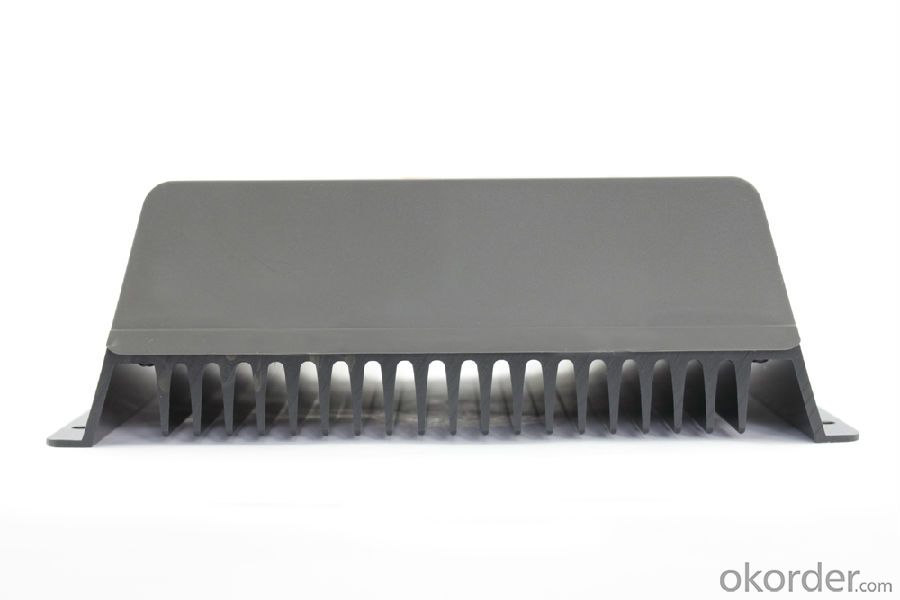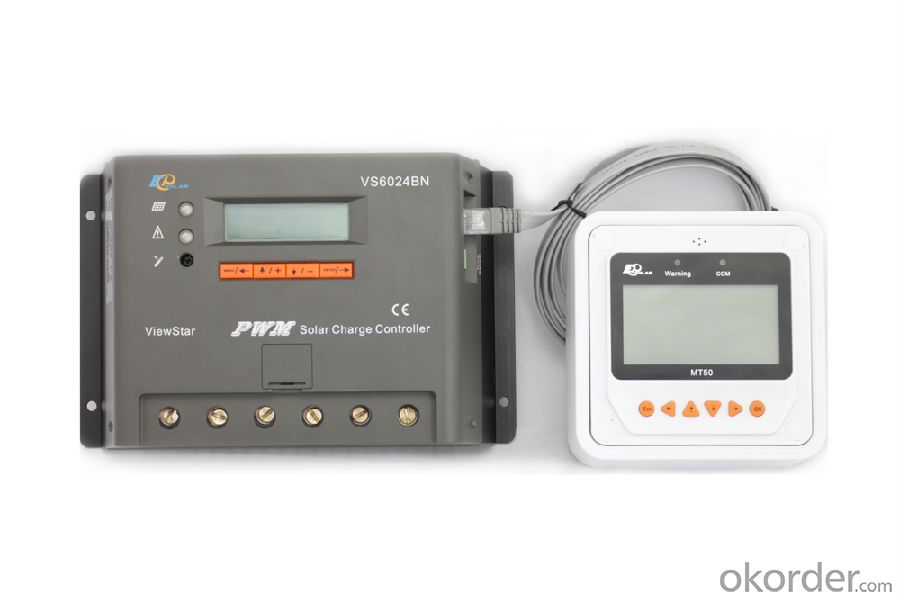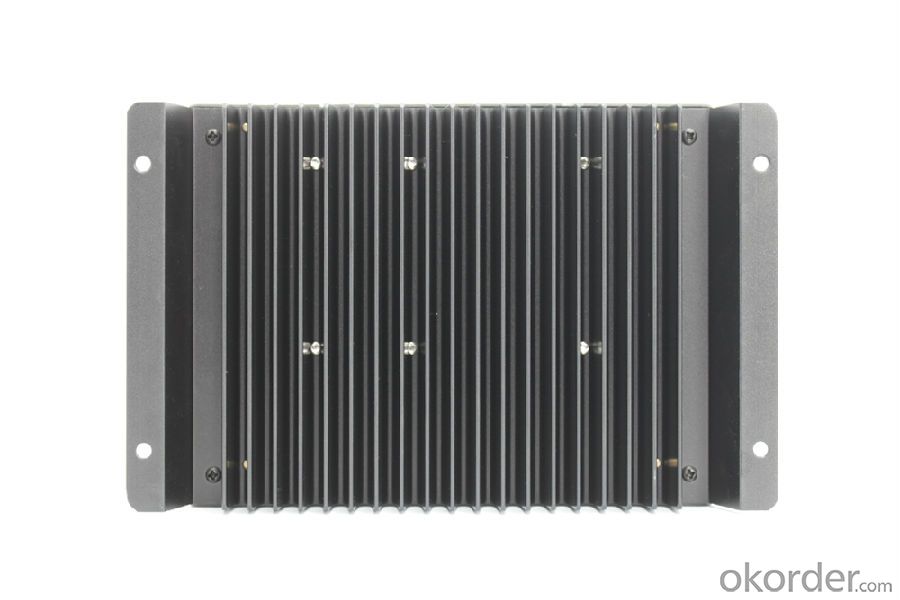LCD/LED High Quality PWM Solar Street Light Charge Controller/Regulator with CE ROHS,60A, 12V/24V,VS6024BN
OKorder Service Pledge
OKorder Financial Service
You Might Also Like
Descriptions:
A solar inverter, or PV inverter, or Solar converter, converts the variable direct current (DC) output of a photovoltaic (PV) solar panel into a utility frequency alternating current (AC) that can be fed into a commercial electrical grid or used by a local, off-grid electrical network. It is a critical BOS–component in a photovoltaic system, allowing the use of ordinary AC-powered equipment. Solar inverters have special functions adapted for use with photovoltaic arrays, including maximum power point tracking and anti-islanding protection.
Features:
·Excellent EMC design
·32 bit MCU with high speed
·High efficient Series PWM charging
·Four battery type options: Sealed, Gel, Flooded, and USER
·Intelligent lighting and timer control for solar lighting system
·12 bit A/D high-precision sampling to ensure accuracy
·Use MOSFET as electronic switch
·Full control parameters setting and modification, diversified load control mode
·Humanized design of browser interface, undertake every operating conveniently
·Temperature compensation
·Adopt graphics dot-matrix LCD screen and HMI (human-machine interface) with 4 buttons,integrated menu displaying and operation
Electronic Protections:
·PV short circuit protection
·PV reverse polarity protection
·Battery overcharge protection
·Battery over discharge protection
·Battery reverse polarity protection
·Load overload protection
·Load short circuit protection
·Overheating protection
Specification:
Model | VS1024BN | VS2024BN | VS3024BN | VS4524BN | VS6024BN |
Nominal system voltage | 12V/24V auto work | ||||
Rated battery current | 10A | 20A | 30A | 45A | 60A |
Rated load current | 10A | 20A | 30A | 45A | 60A |
Max. battery voltage | 32V | ||||
Equalize charging voltage | Sealed: 14.6V, Flooded: 14.8V, User-defined: 9~17V | ||||
Boost charging voltage | Gel: 14.2V, Sealed: 14.6V, Flooded: 14.8V, User-defined: 9~17V | ||||
Float charging voltage | Gel /Sealed /Flooded: 13.8V, User-defined: 9~17V | ||||
Low voltage reconnect voltage | Gel /Sealed /Flooded: 12.6V, User-defined: 9~17V | ||||
Low voltage disconnect voltage | Gel /Sealed /Flooded: 11.1V, User-defined: 9~17V | ||||
Self-consumption | ≤15mA(12V); ≤10mA(24V); ≤9mA(36V); ≤8mA(48V) | ||||
Grounding | Common negative | ||||
Temp. compensation | -3mV/°C/2V | ||||
Relative humidity | 10%~90% Non-condensation | ||||
Communication | RS485 / RJ45 interface | ||||
LCD temperature | -20°C ~ +70°C | ||||
Working temperature | -25°C ~ +55°C | ||||
Humidity | ≤95% N.C. | ||||
Enclosure | IP30 | ||||
Overall dimension | 162x85x40mm | 162x100x50mm | 200x103x58mm | 201x109x59mm | 205x129x67mm |
Terminals | 4mm2 | 10mm2 | 16mm2 | 35mm2 | 35mm2 |
Net weight | 0.2kg | 0.4kg | 0.7kg | 0.9kg | 1.3kg |



- Q:How does a solar controller handle low voltage disconnect for battery protection?
- A solar controller handles low voltage disconnect for battery protection by constantly monitoring the battery voltage. When the voltage drops to a predetermined threshold, typically around 11.5 volts, the controller automatically disconnects the load from the battery. This prevents the battery from being over-discharged, which can lead to permanent damage and reduced lifespan. Once the battery voltage rises above a certain level, usually around 12.6 volts, the controller re-connects the load, ensuring that the battery remains protected and operational.
- Q:How do I determine the maximum load output voltage for a solar controller?
- To determine the maximum load output voltage for a solar controller, you need to refer to the specifications provided by the manufacturer. These specifications typically include the maximum voltage rating for the load output, which is the highest voltage that can be safely handled by the controller without causing any damage or malfunctions. It is crucial to ensure that the load voltage requirements are within the specified range to avoid any potential issues.
- Q:Can a solar controller be used with a solar-powered residential community?
- Yes, a solar controller can be used with a solar-powered residential community. A solar controller is an essential component of a solar power system, and it helps regulate and optimize the charging and discharging of batteries. In a solar-powered residential community, the solar controller would be responsible for managing the flow of electricity from the solar panels to the community's battery storage system, ensuring efficient use of the generated solar energy.
- Q:Can a solar controller be used with a solar pool heating system?
- Yes, a solar controller can be used with a solar pool heating system. A solar controller helps to regulate and monitor the temperature and flow of water in the system, ensuring optimal performance and energy efficiency. It allows users to set desired temperatures and schedule operation times, maximizing the benefits of solar pool heating.
- Q:Can a solar controller be used with different battery types (e.g., lead-acid, lithium-ion)?
- Yes, a solar controller can be used with different battery types, including lead-acid and lithium-ion. However, it is important to select a solar controller that is compatible with the specific battery type you intend to use, as different battery chemistries have different charging and discharging characteristics. Using a solar controller that is not compatible with the battery type can result in inefficient charging, reduced battery lifespan, or even damage to the battery.
- Q:What is the maximum self-consumption of a solar controller?
- The maximum self-consumption of a solar controller refers to the amount of energy that the controller itself consumes from the solar power it manages. This consumption can vary depending on the specific model and features of the controller, but generally, solar controllers have very low self-consumption rates, typically ranging from 1 to 5 watts.
- Q:What is the maximum load current that a solar controller can handle?
- The maximum load current that a solar controller can handle depends on the specific model and its specifications. It is crucial to consult the manufacturer's information or refer to the product manual to determine the maximum load current that a particular solar controller can handle.
- Q:Can a solar controller be used with a solar-powered electric gate?
- Yes, a solar controller can be used with a solar-powered electric gate. A solar controller is designed to regulate and optimize the charging of a solar panel system. In the case of a solar-powered electric gate, the solar controller would manage the charging of the batteries that power the gate. It ensures that the batteries are charged efficiently and prevents overcharging, which can lead to damage. By using a solar controller, the solar-powered electric gate can effectively harness energy from the sun and operate reliably.
- Q:Can a solar controller be used with a solar-powered RV?
- Yes, a solar controller can be used with a solar-powered RV. In fact, it is highly recommended to use a solar controller to regulate the charging and discharging of the RV's batteries. The solar controller helps optimize the charging process, prevents overcharging, and extends the lifespan of the batteries.
- Q:How does a solar controller handle overvoltage protection?
- A solar controller handles overvoltage protection by monitoring the voltage level of the solar panels or batteries connected to it. If the voltage exceeds a certain threshold, the controller automatically shuts off the charging process to prevent damage to the batteries or other connected devices. This protection mechanism ensures that the system operates within safe voltage limits and extends the lifespan of the equipment.
1. Manufacturer Overview |
|
|---|---|
| Location | |
| Year Established | |
| Annual Output Value | |
| Main Markets | |
| Company Certifications | |
2. Manufacturer Certificates |
|
|---|---|
| a) Certification Name | |
| Range | |
| Reference | |
| Validity Period | |
3. Manufacturer Capability |
|
|---|---|
| a)Trade Capacity | |
| Nearest Port | |
| Export Percentage | |
| No.of Employees in Trade Department | |
| Language Spoken: | |
| b)Factory Information | |
| Factory Size: | |
| No. of Production Lines | |
| Contract Manufacturing | |
| Product Price Range | |
Send your message to us
LCD/LED High Quality PWM Solar Street Light Charge Controller/Regulator with CE ROHS,60A, 12V/24V,VS6024BN
OKorder Service Pledge
OKorder Financial Service
Similar products
New products
Hot products
Hot Searches
Related keywords






























